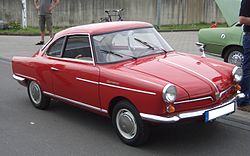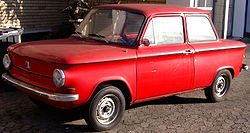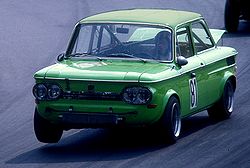- NSU Prinz
-
The NSU Prinz is an automobile produced in West Germany by the NSU Motorenwerke AG. The car was built from 1957 to 1973, and received a model change in 1961 (the old model was continued until 1962).
Contents
NSU Prinz 30
NSU Prinz 30 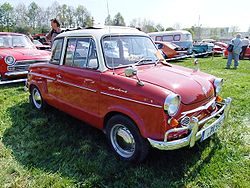
Production 1958-1962 Body style 2-door saloon[1] Engine 583 cc;L Straight-2 [1]
rear-mounted
air-cooledTransmission 4-speed manual all-synchromesh[1] Length 124 in (3,150 mm) [1] Width 56 in (1,422 mm) [1] Height 53 in (1,346 mm)[1] Related Ramses (ET) The first post war NSU car appeared in 1957 accompanied by the advertising slogan "Fahre Prinz und Du bist Koenig" ("Drive a Prince and you're a king").[2] The first generation Prinz was available with a saloon body featuring an upright roof line and seating for four people. The doors opened wide enough to permit reasonable access even to the rear seats, although leg room was severely restricted if attempting to accommodate four full sized adults[1]. In addition to a luggage compartment accessed via a hatch at the front of the car and shared with the spare wheel and fuel filler, there was a narrow but deep full width space behind the rear seat sufficient to accommodate a holiday suitcase[1].
The noisy[1] two-cylinder 600 cc 20 PS (15 kW; 20 hp) engine was located at the back where it drove the rear wheels, initially via a "crash" gearbox. Later versions gained a four-speed all-synchromesh gearbox. Contemporaries were impressed by the brevity of the maintenance schedule, with the engine, gear box and final drive operating as a single chamber and all lubricated by means of oil, added through a filler in the rocker box cover[1]. There were just two grease nipples requiring attention, positioned on the steering kingpins[1]. The engine was also commended in contemporary reports for its fuel economy and longevity[1]. Although noisy, the engine offered impressive flexibility, recalling NSU's strengths as a motorcycle manufacturer[1].
In 1959, a little coupé was added, the Sport Prinz.
NSU Sport Prinz
The Sport Prinz was designed by Franco Scaglione at Bertone studios in Turin. Approximately 20,831 were manufactured between 1959 and 1967. The first 250 bodies were built by Bertone in Turin. The rest were built in Neckarsulm at a company called Drautz which was later bought by NSU.
First models had the Prinz 30 straight-2 engine (583 cc), but a maximum speed of 120 km/h (75 mph) was nevertheless claimed.
Later, the Sport Prinz acquired the 598 cc engine of the Prinz 4.
NSU Prinz 4
NSU Prinz 4 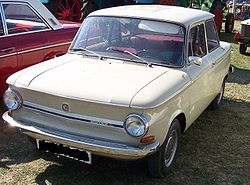
NSU Prinz 4, facelift 1969Also called Ramses II (ET) Production 1961-1973 Body style 2-door saloon[3] Engine 598 cc Straight-2 ohv[3]
rear-mounted
air-cooledTransmission 4-speed manual all-synchromesh[3] Wheelbase 70.3 in (1,786 mm)[3] Length 138 in (3,505 mm) [3] Width 58.6 in (1,488 mm) [3] Height 53.5 in (1,359 mm)[3]  NSU Sport Prinz 1964.The NSU Sportprinz 1958 - 1967 was not much seen outside Germany. However, a spider (convertible) variant was the first production car in the world powered by a rotary Wankel motor.
NSU Sport Prinz 1964.The NSU Sportprinz 1958 - 1967 was not much seen outside Germany. However, a spider (convertible) variant was the first production car in the world powered by a rotary Wankel motor.
One of the revelations of the Frankfurt Motor Show in September 1961,[4] the NSU Prinz 4 replaced the original Prinz. Its new body closely resembled that of the then fashionable Chevrolet Corvair, but was of course much smaller. Like the original Prinz, it was powered by a two-cylinder, air-cooled engine in the rear. The Prinz 4 was much improved and continued to be a well-engineered car, like its predecessors. The engine carried on the tradition of eccentric rod driven camshaft inherited from NSU motorcycle engines and interestingly had a dynastart combined starter/generator built into the crankcase. Later four-cylinder engines adopted the more conventional (pre-engaged) separate starter motor and alternator.
In 1968, Britain's Autocar magazine road tested an NSU Super Prinz. They had previously tested a Prinz 4 in 1962, and in commenting on how little the car had changed in the intervening six years quipped that some of their road testers appeared to have gained more weight than the commendably light-weight Prinz in that period.[3] The tested car achieved a top speed of 113 km/h (70 mph) and accelerated to 97 km/h (60 mph) in 35.7 seconds.[3] The home grown Mini 850 made it to 97 km/h in 29.5 seconds in an equivalent recent test and also managed to beat the NSU's top speed, albeit only by about 3%.[3] At this time the UK car market was heavily protected by tariffs, and the NSU Prinz was retailing in the UK for a manufacturer's recommended retail price of £597, which was more than the (possibly below cost amount of) £561 asked for the 850 cc Mini, but certainly not completely out of touch with it.[3] The testers concluded their report that the car was competitively priced in its class and performed adequately.[3] They opined, cautiously, that it offered 'no more than the rest' but that neither did it 'lack anything important'.
Prinz derivatives
The NSU Prinz evolved into the somewhat larger bodied NSU 1000, NSU 1000TT, NSU 1200TT and NSU TTS models, introduced in 1963. All had the same body with straight-4 aircooled OHC engines and were frequently driven as sports cars, but also as economical family cars as well. The engines were very lively, and highly reliable. Paired with the low total weight, excellent handling and cornering, both the NSU 1000 and the much higher powered NSU 1200 TT/TTS outperformed many sportscars.
In 1965, an even larger model was added, first called Typ 110, and from 1967 on as the NSU 1200. It offered more space, so it was a better family car, but it was not as sporty as the smaller models. Therefore, the NSU 1200TT used the 1200 cc engine of the 1200, but in the smaller body of the NSU 1000.
End of production
When NSU was acquired by Volkswagen in 1969, it was merged with Auto Union AG. Auto Union had previously been taken over by VW in 1964 and produced mid-sized cars, resurrecting the Audi marque. The name of the new company changed to Audi NSU Auto Union AG. The small, rear-engined NSU models were phased out in 1973, as they were far too competitive against Volkswagen's own Beetle[citation needed] and production capacity was needed for larger and more profitable Audi models. The successor of the NSU Prinz was the front-wheel driven Audi 50, later rebadged as the Volkswagen Polo.
Related models
According to some sources, in 1966, the Soviet manufacturer ZAZ created a virtual copy of the NSU Prinz — the ZAZ-966, but the chassis was totally different from the NSU; the engine was an air-cooled 900 cc V4 producing 30 PS (22 kW) (later, a 1200 cc 40 PS (29 kW)). However, the prototypes of the ZAZ-966 were ready in 1961 and both cars in fact were heavily influenced by the Chevrolet Corvair, which was intensively tested on the plant just prior to the 966's development in early 1960s[5].
Under license, the Prinz was manufactured in Sarajevo, Bosnia, by PRETIS (Preduzece Tito Sarajevo) factories.
The NSU Prinz was also manufactured in Argentina by Autoar, making mainly models Prinz II and Prinz III / 30. It is told that only 40-45 Sportprinz were imported and a few Prinz IV (less than 10).
The Ramses was the first car produced in Egypt, and was the result of a co-operation between the new Egyptian car firm Egyptian Light Transport Manufacturing Company, and the German NSU. The factory was located right next to the Great Pyramids. Plans were to produce around 10.000 cars a year, most of the work being manual labor.
References
- ^ a b c d e f g h i j k l m "Knowing Your NSU Prinz 30". Practical Motorist 7 nbr 79: pages 709–710. March 1961.
- ^ "Not und Spiele: Die 50er Jahre...". Auto Motor u. Sport Heft 13 1996: Seite 58–65. date 14 June 1996.
- ^ a b c d e f g h i j k l "Autotest: NSU Super Prinz". Autocar 129 nbr 3785: pages 18–22. 29 August 1968.
- ^ "Automobilia". Toutes les voitures françaises 1962 (salon Paris oct 1961) (Paris: Histoire & collections) Nr. 19: Page 74. 2001.
- ^ ZAZ-966 "Zaporozhets", Avtolegendy SSSR Nr.36, DeAgostini 2010, ISSN 2071-095X, (Russian)
External links
Categories:- NSU vehicles
- Rear-engined vehicles
Wikimedia Foundation. 2010.

